In-Depth Analysis of Nursing Principles and Patient-Centered Care
VerifiedAdded on 2020/03/16
|12
|3662
|98
Essay
AI Summary
This assignment provides a comprehensive analysis of nursing principles, specifically focusing on Principle A, which emphasizes patient respect and dignity, and Principles C and D, which address risk management and patient-centered care, respectively. The student reflects on a personal experience involving a patient's wound care, using the Gibbs reflection model to explore the incident's impact on their understanding of nursing principles. The essay delves into the importance of non-verbal communication, maintaining patient privacy and confidentiality, and integrating patient families into the care process. It also examines how the student's actions aligned with or deviated from RCN and NMC guidelines. Through this reflective analysis, the assignment underscores the critical role of nurses in ensuring patient safety, promoting ethical practice, and fostering a holistic approach to healthcare that prioritizes the patient's well-being and involvement.
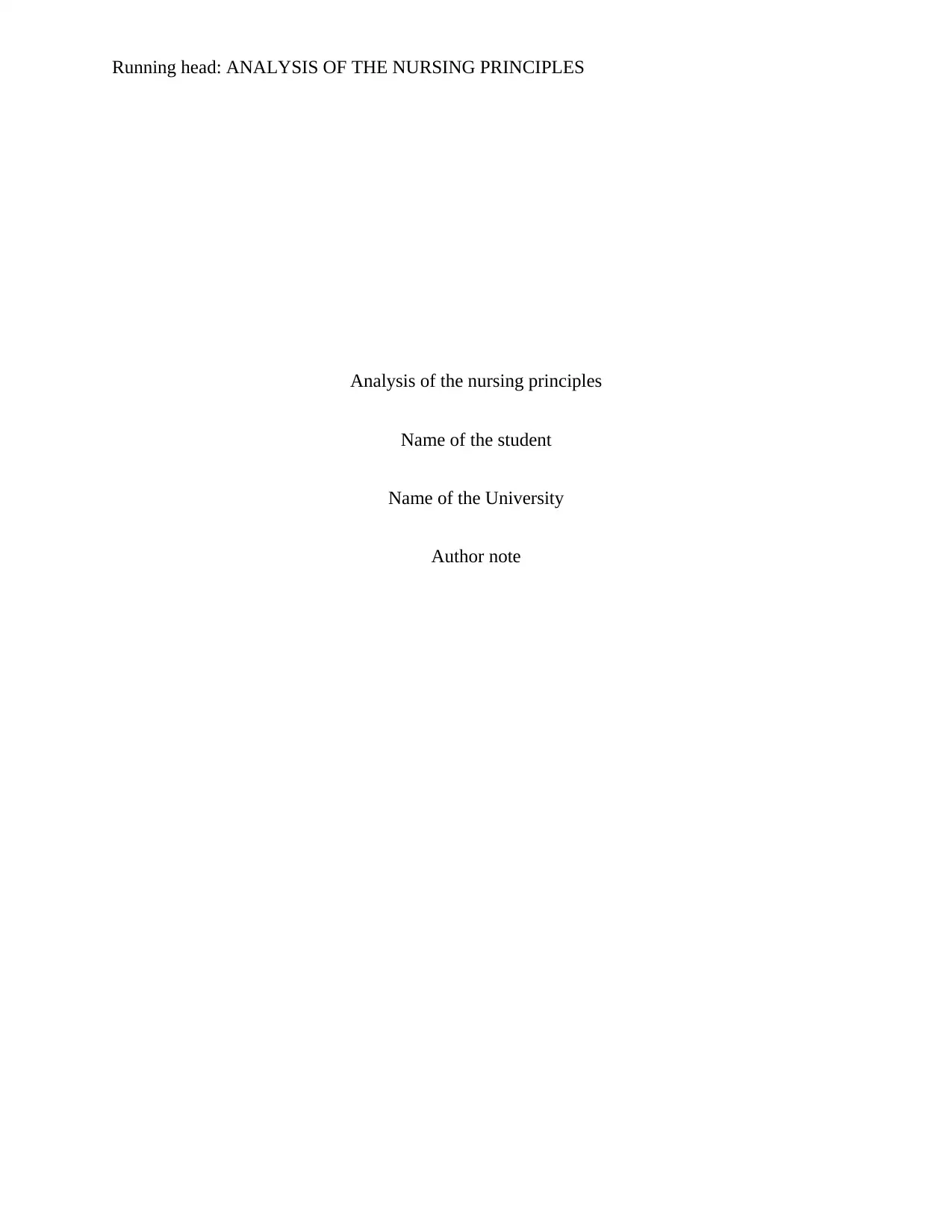
Running head: ANALYSIS OF THE NURSING PRINCIPLES
Analysis of the nursing principles
Name of the student
Name of the University
Author note
Analysis of the nursing principles
Name of the student
Name of the University
Author note
Paraphrase This Document
Need a fresh take? Get an instant paraphrase of this document with our AI Paraphraser
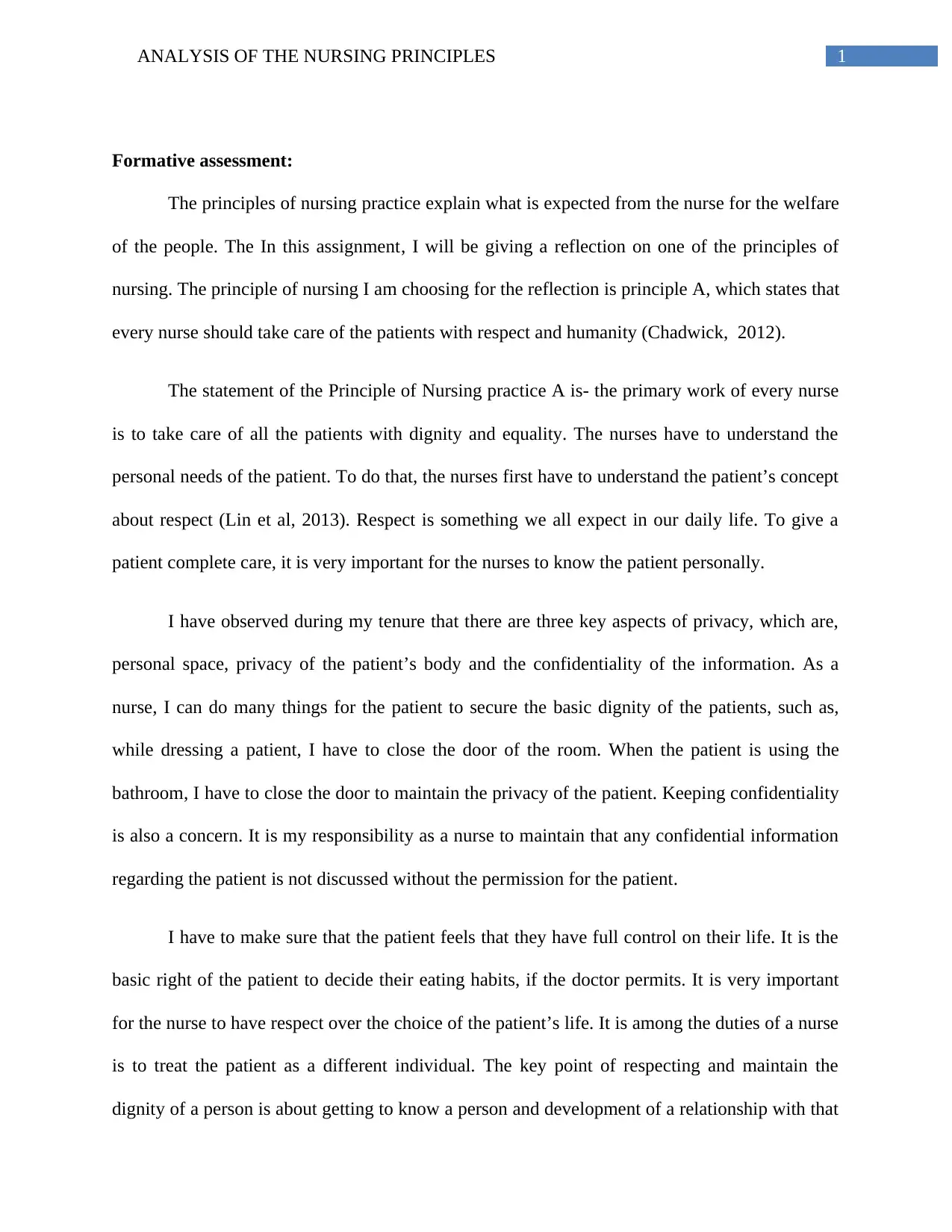
1ANALYSIS OF THE NURSING PRINCIPLES
Formative assessment:
The principles of nursing practice explain what is expected from the nurse for the welfare
of the people. The In this assignment, I will be giving a reflection on one of the principles of
nursing. The principle of nursing I am choosing for the reflection is principle A, which states that
every nurse should take care of the patients with respect and humanity (Chadwick, 2012).
The statement of the Principle of Nursing practice A is- the primary work of every nurse
is to take care of all the patients with dignity and equality. The nurses have to understand the
personal needs of the patient. To do that, the nurses first have to understand the patient’s concept
about respect (Lin et al, 2013). Respect is something we all expect in our daily life. To give a
patient complete care, it is very important for the nurses to know the patient personally.
I have observed during my tenure that there are three key aspects of privacy, which are,
personal space, privacy of the patient’s body and the confidentiality of the information. As a
nurse, I can do many things for the patient to secure the basic dignity of the patients, such as,
while dressing a patient, I have to close the door of the room. When the patient is using the
bathroom, I have to close the door to maintain the privacy of the patient. Keeping confidentiality
is also a concern. It is my responsibility as a nurse to maintain that any confidential information
regarding the patient is not discussed without the permission for the patient.
I have to make sure that the patient feels that they have full control on their life. It is the
basic right of the patient to decide their eating habits, if the doctor permits. It is very important
for the nurse to have respect over the choice of the patient’s life. It is among the duties of a nurse
is to treat the patient as a different individual. The key point of respecting and maintain the
dignity of a person is about getting to know a person and development of a relationship with that
Formative assessment:
The principles of nursing practice explain what is expected from the nurse for the welfare
of the people. The In this assignment, I will be giving a reflection on one of the principles of
nursing. The principle of nursing I am choosing for the reflection is principle A, which states that
every nurse should take care of the patients with respect and humanity (Chadwick, 2012).
The statement of the Principle of Nursing practice A is- the primary work of every nurse
is to take care of all the patients with dignity and equality. The nurses have to understand the
personal needs of the patient. To do that, the nurses first have to understand the patient’s concept
about respect (Lin et al, 2013). Respect is something we all expect in our daily life. To give a
patient complete care, it is very important for the nurses to know the patient personally.
I have observed during my tenure that there are three key aspects of privacy, which are,
personal space, privacy of the patient’s body and the confidentiality of the information. As a
nurse, I can do many things for the patient to secure the basic dignity of the patients, such as,
while dressing a patient, I have to close the door of the room. When the patient is using the
bathroom, I have to close the door to maintain the privacy of the patient. Keeping confidentiality
is also a concern. It is my responsibility as a nurse to maintain that any confidential information
regarding the patient is not discussed without the permission for the patient.
I have to make sure that the patient feels that they have full control on their life. It is the
basic right of the patient to decide their eating habits, if the doctor permits. It is very important
for the nurse to have respect over the choice of the patient’s life. It is among the duties of a nurse
is to treat the patient as a different individual. The key point of respecting and maintain the
dignity of a person is about getting to know a person and development of a relationship with that

2ANALYSIS OF THE NURSING PRINCIPLES
person (Card, Ward, and Clarkson, 2012). From the cases I handled, I learnt that the non-verbal
communication has the same importance as verbal communication. As a nurse, I have to properly
interact with the patients (Gastmans, 2013).
The NMC guideline also echoes the nursing practice principle A, as it clearly directs the
nurses to treat the patient with empathy, respect and kindness. It also directs the nurses to listen
to the patients about their concerns and keep the practitioner-patient information confidentiality
(Oosterveld-Vlug et al., 2013). The NMC guideline provides detailed instructions to the nurses
about how to maintain a patient’s confidentiality, basic dignity and physical privacy (Sabatino et
al, 2014). There are many policies in healthcare, which the nurses also have to follow. These
policies also support and promote respect and dignity in healthcare. All these policies and
guidelines support the basic principles of nursing.
person (Card, Ward, and Clarkson, 2012). From the cases I handled, I learnt that the non-verbal
communication has the same importance as verbal communication. As a nurse, I have to properly
interact with the patients (Gastmans, 2013).
The NMC guideline also echoes the nursing practice principle A, as it clearly directs the
nurses to treat the patient with empathy, respect and kindness. It also directs the nurses to listen
to the patients about their concerns and keep the practitioner-patient information confidentiality
(Oosterveld-Vlug et al., 2013). The NMC guideline provides detailed instructions to the nurses
about how to maintain a patient’s confidentiality, basic dignity and physical privacy (Sabatino et
al, 2014). There are many policies in healthcare, which the nurses also have to follow. These
policies also support and promote respect and dignity in healthcare. All these policies and
guidelines support the basic principles of nursing.
⊘ This is a preview!⊘
Do you want full access?
Subscribe today to unlock all pages.

Trusted by 1+ million students worldwide
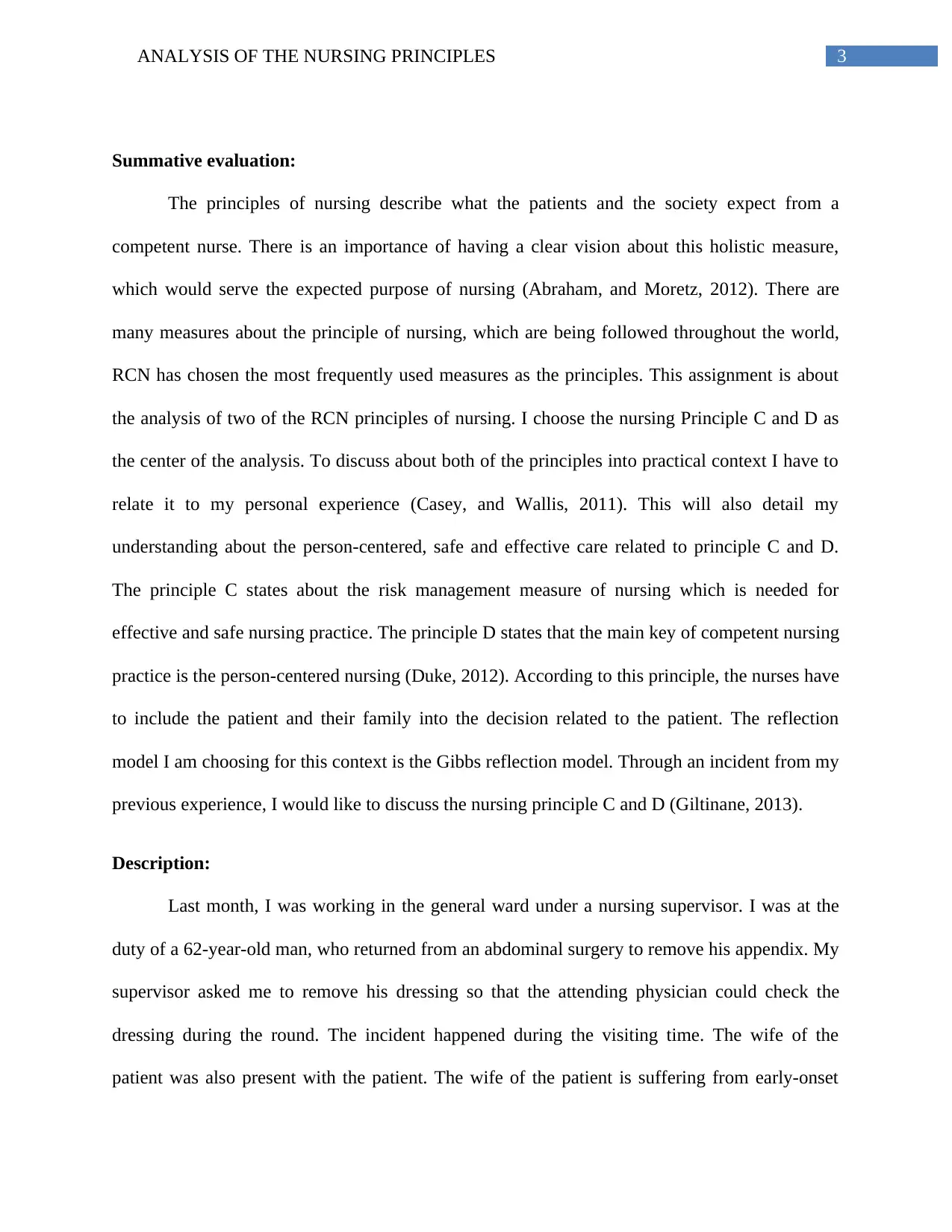
3ANALYSIS OF THE NURSING PRINCIPLES
Summative evaluation:
The principles of nursing describe what the patients and the society expect from a
competent nurse. There is an importance of having a clear vision about this holistic measure,
which would serve the expected purpose of nursing (Abraham, and Moretz, 2012). There are
many measures about the principle of nursing, which are being followed throughout the world,
RCN has chosen the most frequently used measures as the principles. This assignment is about
the analysis of two of the RCN principles of nursing. I choose the nursing Principle C and D as
the center of the analysis. To discuss about both of the principles into practical context I have to
relate it to my personal experience (Casey, and Wallis, 2011). This will also detail my
understanding about the person-centered, safe and effective care related to principle C and D.
The principle C states about the risk management measure of nursing which is needed for
effective and safe nursing practice. The principle D states that the main key of competent nursing
practice is the person-centered nursing (Duke, 2012). According to this principle, the nurses have
to include the patient and their family into the decision related to the patient. The reflection
model I am choosing for this context is the Gibbs reflection model. Through an incident from my
previous experience, I would like to discuss the nursing principle C and D (Giltinane, 2013).
Description:
Last month, I was working in the general ward under a nursing supervisor. I was at the
duty of a 62-year-old man, who returned from an abdominal surgery to remove his appendix. My
supervisor asked me to remove his dressing so that the attending physician could check the
dressing during the round. The incident happened during the visiting time. The wife of the
patient was also present with the patient. The wife of the patient is suffering from early-onset
Summative evaluation:
The principles of nursing describe what the patients and the society expect from a
competent nurse. There is an importance of having a clear vision about this holistic measure,
which would serve the expected purpose of nursing (Abraham, and Moretz, 2012). There are
many measures about the principle of nursing, which are being followed throughout the world,
RCN has chosen the most frequently used measures as the principles. This assignment is about
the analysis of two of the RCN principles of nursing. I choose the nursing Principle C and D as
the center of the analysis. To discuss about both of the principles into practical context I have to
relate it to my personal experience (Casey, and Wallis, 2011). This will also detail my
understanding about the person-centered, safe and effective care related to principle C and D.
The principle C states about the risk management measure of nursing which is needed for
effective and safe nursing practice. The principle D states that the main key of competent nursing
practice is the person-centered nursing (Duke, 2012). According to this principle, the nurses have
to include the patient and their family into the decision related to the patient. The reflection
model I am choosing for this context is the Gibbs reflection model. Through an incident from my
previous experience, I would like to discuss the nursing principle C and D (Giltinane, 2013).
Description:
Last month, I was working in the general ward under a nursing supervisor. I was at the
duty of a 62-year-old man, who returned from an abdominal surgery to remove his appendix. My
supervisor asked me to remove his dressing so that the attending physician could check the
dressing during the round. The incident happened during the visiting time. The wife of the
patient was also present with the patient. The wife of the patient is suffering from early-onset
Paraphrase This Document
Need a fresh take? Get an instant paraphrase of this document with our AI Paraphraser
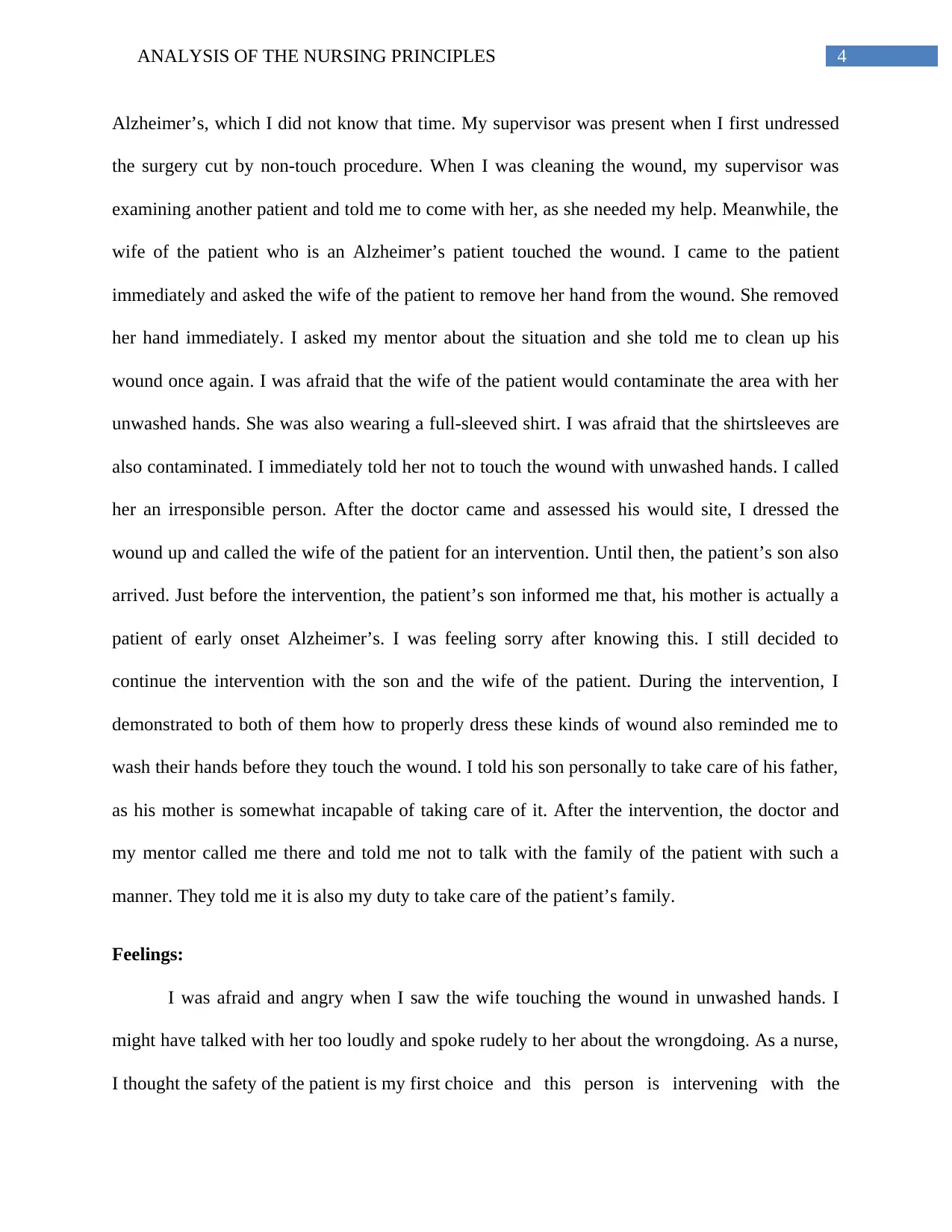
4ANALYSIS OF THE NURSING PRINCIPLES
Alzheimer’s, which I did not know that time. My supervisor was present when I first undressed
the surgery cut by non-touch procedure. When I was cleaning the wound, my supervisor was
examining another patient and told me to come with her, as she needed my help. Meanwhile, the
wife of the patient who is an Alzheimer’s patient touched the wound. I came to the patient
immediately and asked the wife of the patient to remove her hand from the wound. She removed
her hand immediately. I asked my mentor about the situation and she told me to clean up his
wound once again. I was afraid that the wife of the patient would contaminate the area with her
unwashed hands. She was also wearing a full-sleeved shirt. I was afraid that the shirtsleeves are
also contaminated. I immediately told her not to touch the wound with unwashed hands. I called
her an irresponsible person. After the doctor came and assessed his would site, I dressed the
wound up and called the wife of the patient for an intervention. Until then, the patient’s son also
arrived. Just before the intervention, the patient’s son informed me that, his mother is actually a
patient of early onset Alzheimer’s. I was feeling sorry after knowing this. I still decided to
continue the intervention with the son and the wife of the patient. During the intervention, I
demonstrated to both of them how to properly dress these kinds of wound also reminded me to
wash their hands before they touch the wound. I told his son personally to take care of his father,
as his mother is somewhat incapable of taking care of it. After the intervention, the doctor and
my mentor called me there and told me not to talk with the family of the patient with such a
manner. They told me it is also my duty to take care of the patient’s family.
Feelings:
I was afraid and angry when I saw the wife touching the wound in unwashed hands. I
might have talked with her too loudly and spoke rudely to her about the wrongdoing. As a nurse,
I thought the safety of the patient is my first choice and this person is intervening with the
Alzheimer’s, which I did not know that time. My supervisor was present when I first undressed
the surgery cut by non-touch procedure. When I was cleaning the wound, my supervisor was
examining another patient and told me to come with her, as she needed my help. Meanwhile, the
wife of the patient who is an Alzheimer’s patient touched the wound. I came to the patient
immediately and asked the wife of the patient to remove her hand from the wound. She removed
her hand immediately. I asked my mentor about the situation and she told me to clean up his
wound once again. I was afraid that the wife of the patient would contaminate the area with her
unwashed hands. She was also wearing a full-sleeved shirt. I was afraid that the shirtsleeves are
also contaminated. I immediately told her not to touch the wound with unwashed hands. I called
her an irresponsible person. After the doctor came and assessed his would site, I dressed the
wound up and called the wife of the patient for an intervention. Until then, the patient’s son also
arrived. Just before the intervention, the patient’s son informed me that, his mother is actually a
patient of early onset Alzheimer’s. I was feeling sorry after knowing this. I still decided to
continue the intervention with the son and the wife of the patient. During the intervention, I
demonstrated to both of them how to properly dress these kinds of wound also reminded me to
wash their hands before they touch the wound. I told his son personally to take care of his father,
as his mother is somewhat incapable of taking care of it. After the intervention, the doctor and
my mentor called me there and told me not to talk with the family of the patient with such a
manner. They told me it is also my duty to take care of the patient’s family.
Feelings:
I was afraid and angry when I saw the wife touching the wound in unwashed hands. I
might have talked with her too loudly and spoke rudely to her about the wrongdoing. As a nurse,
I thought the safety of the patient is my first choice and this person is intervening with the
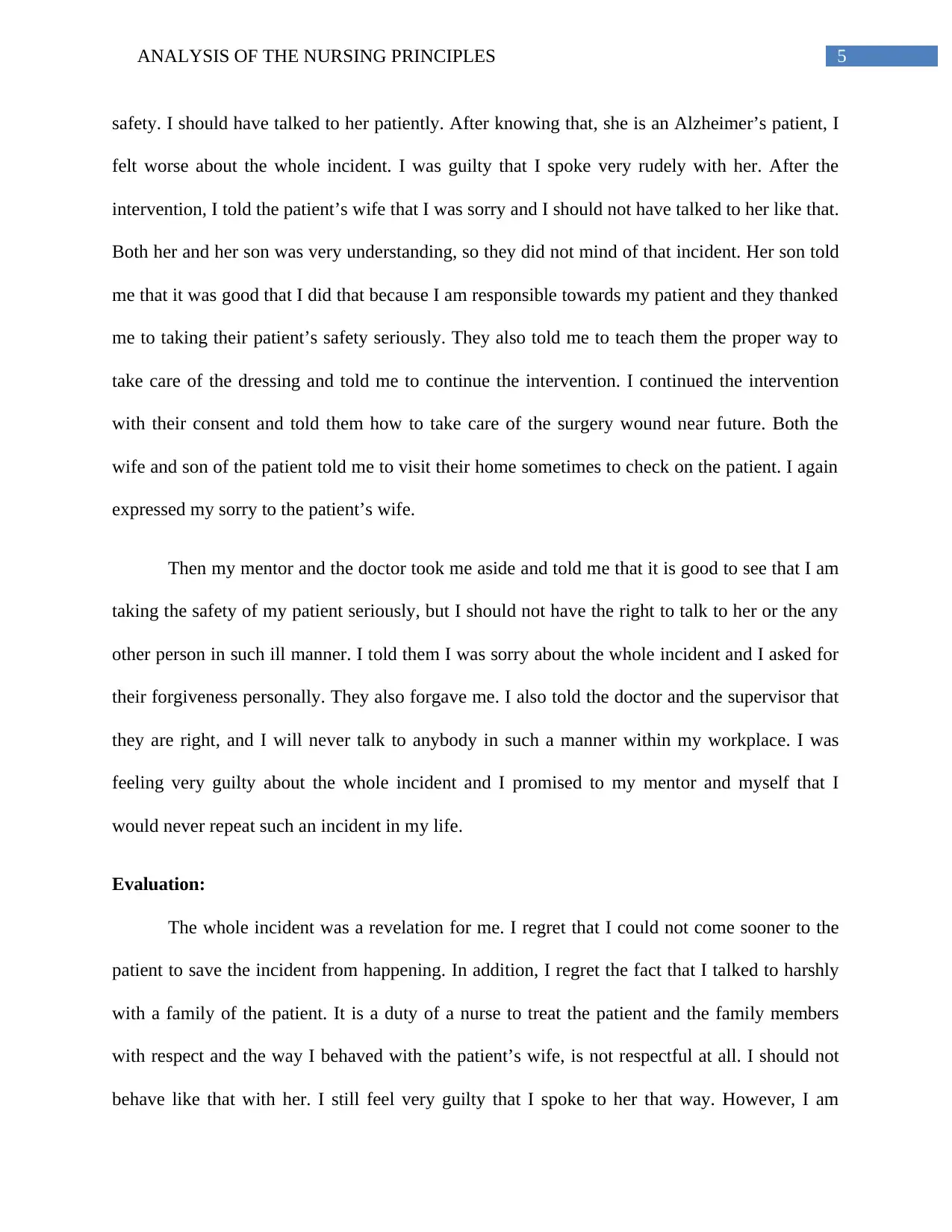
5ANALYSIS OF THE NURSING PRINCIPLES
safety. I should have talked to her patiently. After knowing that, she is an Alzheimer’s patient, I
felt worse about the whole incident. I was guilty that I spoke very rudely with her. After the
intervention, I told the patient’s wife that I was sorry and I should not have talked to her like that.
Both her and her son was very understanding, so they did not mind of that incident. Her son told
me that it was good that I did that because I am responsible towards my patient and they thanked
me to taking their patient’s safety seriously. They also told me to teach them the proper way to
take care of the dressing and told me to continue the intervention. I continued the intervention
with their consent and told them how to take care of the surgery wound near future. Both the
wife and son of the patient told me to visit their home sometimes to check on the patient. I again
expressed my sorry to the patient’s wife.
Then my mentor and the doctor took me aside and told me that it is good to see that I am
taking the safety of my patient seriously, but I should not have the right to talk to her or the any
other person in such ill manner. I told them I was sorry about the whole incident and I asked for
their forgiveness personally. They also forgave me. I also told the doctor and the supervisor that
they are right, and I will never talk to anybody in such a manner within my workplace. I was
feeling very guilty about the whole incident and I promised to my mentor and myself that I
would never repeat such an incident in my life.
Evaluation:
The whole incident was a revelation for me. I regret that I could not come sooner to the
patient to save the incident from happening. In addition, I regret the fact that I talked to harshly
with a family of the patient. It is a duty of a nurse to treat the patient and the family members
with respect and the way I behaved with the patient’s wife, is not respectful at all. I should not
behave like that with her. I still feel very guilty that I spoke to her that way. However, I am
safety. I should have talked to her patiently. After knowing that, she is an Alzheimer’s patient, I
felt worse about the whole incident. I was guilty that I spoke very rudely with her. After the
intervention, I told the patient’s wife that I was sorry and I should not have talked to her like that.
Both her and her son was very understanding, so they did not mind of that incident. Her son told
me that it was good that I did that because I am responsible towards my patient and they thanked
me to taking their patient’s safety seriously. They also told me to teach them the proper way to
take care of the dressing and told me to continue the intervention. I continued the intervention
with their consent and told them how to take care of the surgery wound near future. Both the
wife and son of the patient told me to visit their home sometimes to check on the patient. I again
expressed my sorry to the patient’s wife.
Then my mentor and the doctor took me aside and told me that it is good to see that I am
taking the safety of my patient seriously, but I should not have the right to talk to her or the any
other person in such ill manner. I told them I was sorry about the whole incident and I asked for
their forgiveness personally. They also forgave me. I also told the doctor and the supervisor that
they are right, and I will never talk to anybody in such a manner within my workplace. I was
feeling very guilty about the whole incident and I promised to my mentor and myself that I
would never repeat such an incident in my life.
Evaluation:
The whole incident was a revelation for me. I regret that I could not come sooner to the
patient to save the incident from happening. In addition, I regret the fact that I talked to harshly
with a family of the patient. It is a duty of a nurse to treat the patient and the family members
with respect and the way I behaved with the patient’s wife, is not respectful at all. I should not
behave like that with her. I still feel very guilty that I spoke to her that way. However, I am
⊘ This is a preview!⊘
Do you want full access?
Subscribe today to unlock all pages.

Trusted by 1+ million students worldwide
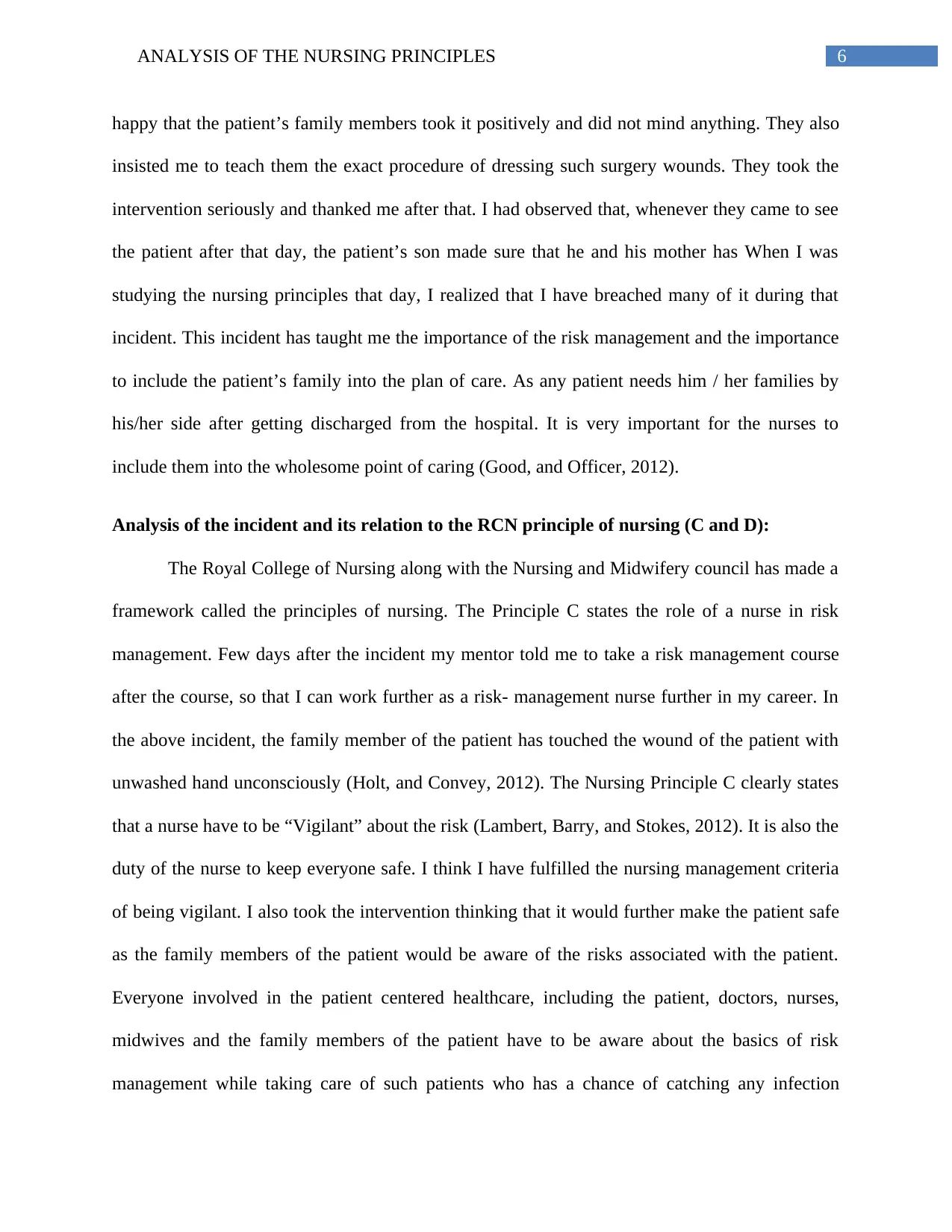
6ANALYSIS OF THE NURSING PRINCIPLES
happy that the patient’s family members took it positively and did not mind anything. They also
insisted me to teach them the exact procedure of dressing such surgery wounds. They took the
intervention seriously and thanked me after that. I had observed that, whenever they came to see
the patient after that day, the patient’s son made sure that he and his mother has When I was
studying the nursing principles that day, I realized that I have breached many of it during that
incident. This incident has taught me the importance of the risk management and the importance
to include the patient’s family into the plan of care. As any patient needs him / her families by
his/her side after getting discharged from the hospital. It is very important for the nurses to
include them into the wholesome point of caring (Good, and Officer, 2012).
Analysis of the incident and its relation to the RCN principle of nursing (C and D):
The Royal College of Nursing along with the Nursing and Midwifery council has made a
framework called the principles of nursing. The Principle C states the role of a nurse in risk
management. Few days after the incident my mentor told me to take a risk management course
after the course, so that I can work further as a risk- management nurse further in my career. In
the above incident, the family member of the patient has touched the wound of the patient with
unwashed hand unconsciously (Holt, and Convey, 2012). The Nursing Principle C clearly states
that a nurse have to be “Vigilant” about the risk (Lambert, Barry, and Stokes, 2012). It is also the
duty of the nurse to keep everyone safe. I think I have fulfilled the nursing management criteria
of being vigilant. I also took the intervention thinking that it would further make the patient safe
as the family members of the patient would be aware of the risks associated with the patient.
Everyone involved in the patient centered healthcare, including the patient, doctors, nurses,
midwives and the family members of the patient have to be aware about the basics of risk
management while taking care of such patients who has a chance of catching any infection
happy that the patient’s family members took it positively and did not mind anything. They also
insisted me to teach them the exact procedure of dressing such surgery wounds. They took the
intervention seriously and thanked me after that. I had observed that, whenever they came to see
the patient after that day, the patient’s son made sure that he and his mother has When I was
studying the nursing principles that day, I realized that I have breached many of it during that
incident. This incident has taught me the importance of the risk management and the importance
to include the patient’s family into the plan of care. As any patient needs him / her families by
his/her side after getting discharged from the hospital. It is very important for the nurses to
include them into the wholesome point of caring (Good, and Officer, 2012).
Analysis of the incident and its relation to the RCN principle of nursing (C and D):
The Royal College of Nursing along with the Nursing and Midwifery council has made a
framework called the principles of nursing. The Principle C states the role of a nurse in risk
management. Few days after the incident my mentor told me to take a risk management course
after the course, so that I can work further as a risk- management nurse further in my career. In
the above incident, the family member of the patient has touched the wound of the patient with
unwashed hand unconsciously (Holt, and Convey, 2012). The Nursing Principle C clearly states
that a nurse have to be “Vigilant” about the risk (Lambert, Barry, and Stokes, 2012). It is also the
duty of the nurse to keep everyone safe. I think I have fulfilled the nursing management criteria
of being vigilant. I also took the intervention thinking that it would further make the patient safe
as the family members of the patient would be aware of the risks associated with the patient.
Everyone involved in the patient centered healthcare, including the patient, doctors, nurses,
midwives and the family members of the patient have to be aware about the basics of risk
management while taking care of such patients who has a chance of catching any infection
Paraphrase This Document
Need a fresh take? Get an instant paraphrase of this document with our AI Paraphraser
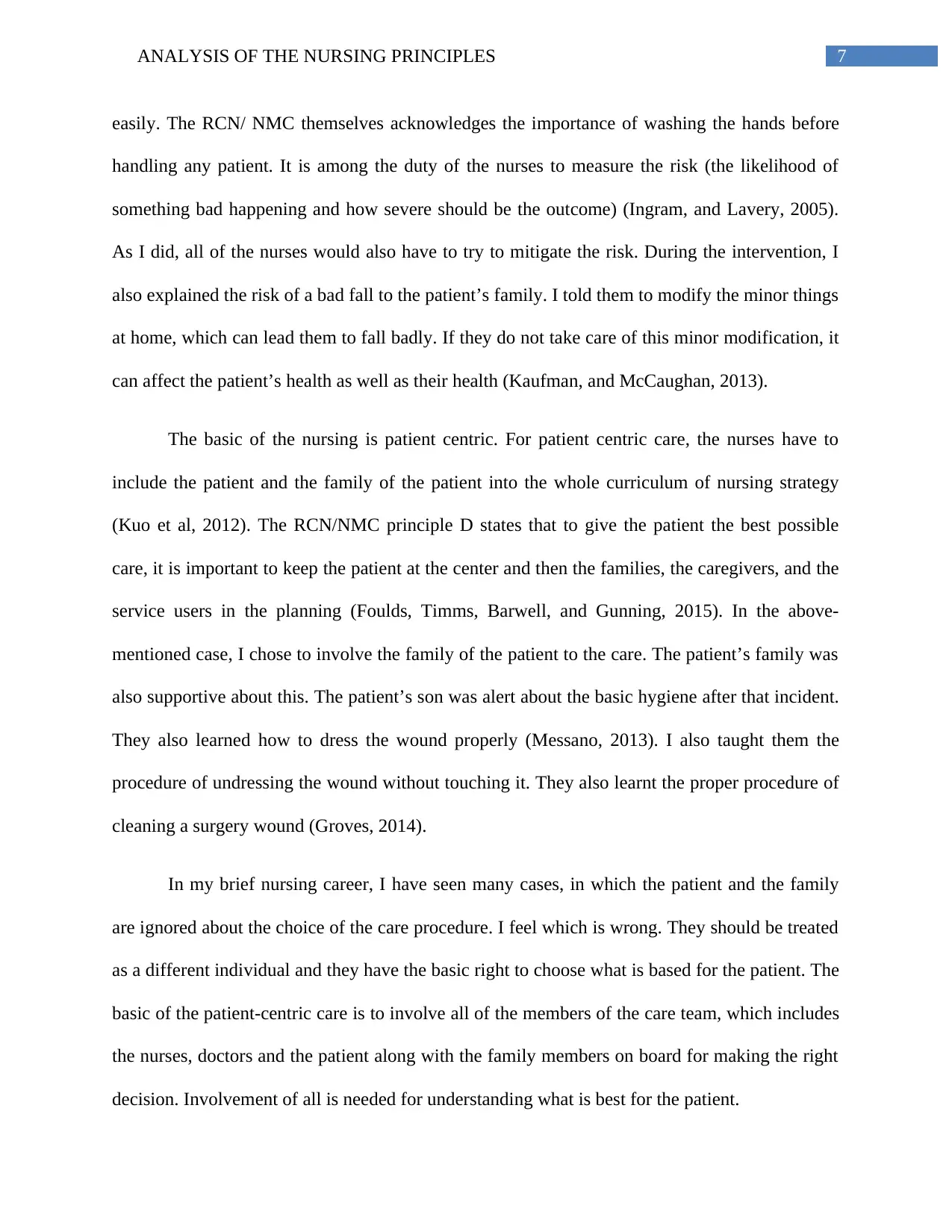
7ANALYSIS OF THE NURSING PRINCIPLES
easily. The RCN/ NMC themselves acknowledges the importance of washing the hands before
handling any patient. It is among the duty of the nurses to measure the risk (the likelihood of
something bad happening and how severe should be the outcome) (Ingram, and Lavery, 2005).
As I did, all of the nurses would also have to try to mitigate the risk. During the intervention, I
also explained the risk of a bad fall to the patient’s family. I told them to modify the minor things
at home, which can lead them to fall badly. If they do not take care of this minor modification, it
can affect the patient’s health as well as their health (Kaufman, and McCaughan, 2013).
The basic of the nursing is patient centric. For patient centric care, the nurses have to
include the patient and the family of the patient into the whole curriculum of nursing strategy
(Kuo et al, 2012). The RCN/NMC principle D states that to give the patient the best possible
care, it is important to keep the patient at the center and then the families, the caregivers, and the
service users in the planning (Foulds, Timms, Barwell, and Gunning, 2015). In the above-
mentioned case, I chose to involve the family of the patient to the care. The patient’s family was
also supportive about this. The patient’s son was alert about the basic hygiene after that incident.
They also learned how to dress the wound properly (Messano, 2013). I also taught them the
procedure of undressing the wound without touching it. They also learnt the proper procedure of
cleaning a surgery wound (Groves, 2014).
In my brief nursing career, I have seen many cases, in which the patient and the family
are ignored about the choice of the care procedure. I feel which is wrong. They should be treated
as a different individual and they have the basic right to choose what is based for the patient. The
basic of the patient-centric care is to involve all of the members of the care team, which includes
the nurses, doctors and the patient along with the family members on board for making the right
decision. Involvement of all is needed for understanding what is best for the patient.
easily. The RCN/ NMC themselves acknowledges the importance of washing the hands before
handling any patient. It is among the duty of the nurses to measure the risk (the likelihood of
something bad happening and how severe should be the outcome) (Ingram, and Lavery, 2005).
As I did, all of the nurses would also have to try to mitigate the risk. During the intervention, I
also explained the risk of a bad fall to the patient’s family. I told them to modify the minor things
at home, which can lead them to fall badly. If they do not take care of this minor modification, it
can affect the patient’s health as well as their health (Kaufman, and McCaughan, 2013).
The basic of the nursing is patient centric. For patient centric care, the nurses have to
include the patient and the family of the patient into the whole curriculum of nursing strategy
(Kuo et al, 2012). The RCN/NMC principle D states that to give the patient the best possible
care, it is important to keep the patient at the center and then the families, the caregivers, and the
service users in the planning (Foulds, Timms, Barwell, and Gunning, 2015). In the above-
mentioned case, I chose to involve the family of the patient to the care. The patient’s family was
also supportive about this. The patient’s son was alert about the basic hygiene after that incident.
They also learned how to dress the wound properly (Messano, 2013). I also taught them the
procedure of undressing the wound without touching it. They also learnt the proper procedure of
cleaning a surgery wound (Groves, 2014).
In my brief nursing career, I have seen many cases, in which the patient and the family
are ignored about the choice of the care procedure. I feel which is wrong. They should be treated
as a different individual and they have the basic right to choose what is based for the patient. The
basic of the patient-centric care is to involve all of the members of the care team, which includes
the nurses, doctors and the patient along with the family members on board for making the right
decision. Involvement of all is needed for understanding what is best for the patient.
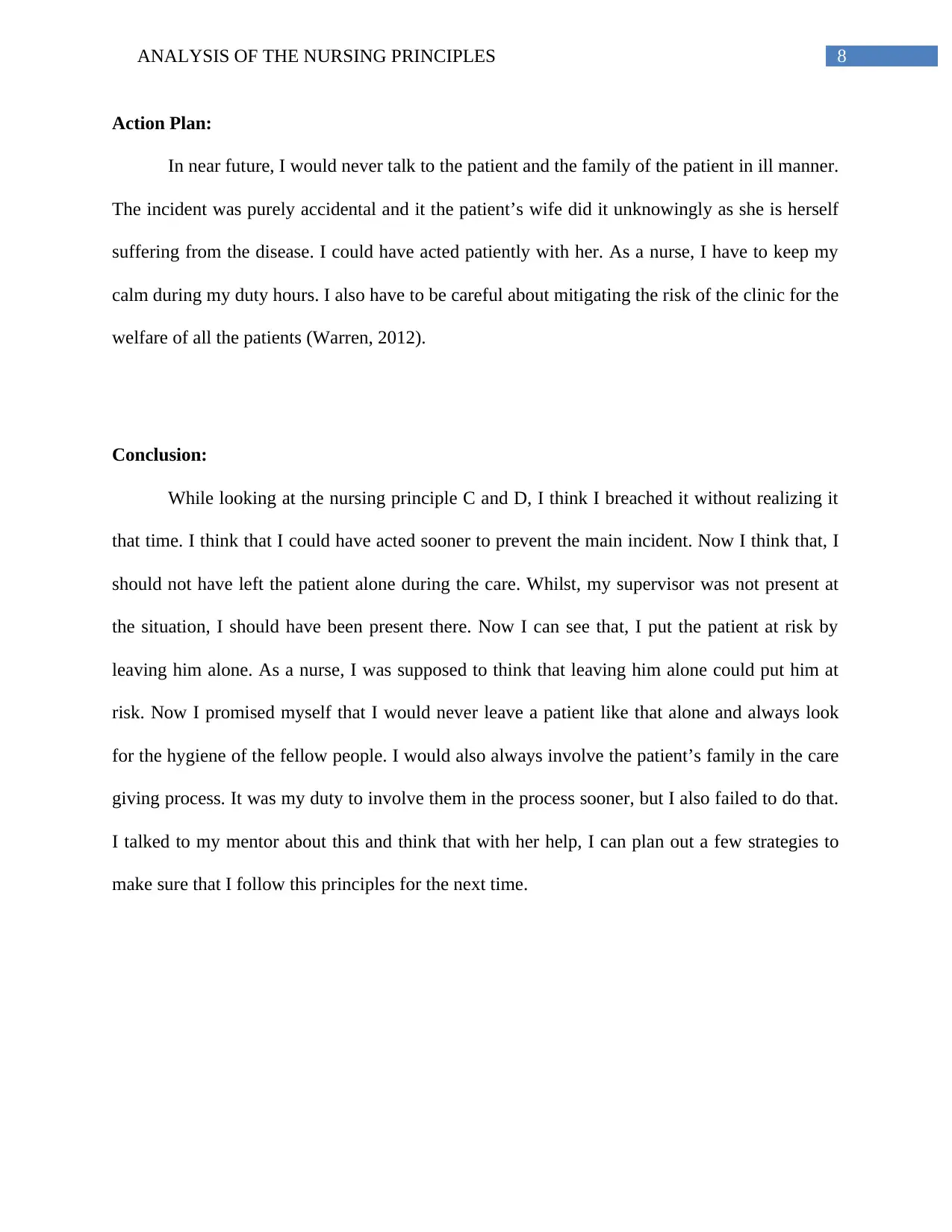
8ANALYSIS OF THE NURSING PRINCIPLES
Action Plan:
In near future, I would never talk to the patient and the family of the patient in ill manner.
The incident was purely accidental and it the patient’s wife did it unknowingly as she is herself
suffering from the disease. I could have acted patiently with her. As a nurse, I have to keep my
calm during my duty hours. I also have to be careful about mitigating the risk of the clinic for the
welfare of all the patients (Warren, 2012).
Conclusion:
While looking at the nursing principle C and D, I think I breached it without realizing it
that time. I think that I could have acted sooner to prevent the main incident. Now I think that, I
should not have left the patient alone during the care. Whilst, my supervisor was not present at
the situation, I should have been present there. Now I can see that, I put the patient at risk by
leaving him alone. As a nurse, I was supposed to think that leaving him alone could put him at
risk. Now I promised myself that I would never leave a patient like that alone and always look
for the hygiene of the fellow people. I would also always involve the patient’s family in the care
giving process. It was my duty to involve them in the process sooner, but I also failed to do that.
I talked to my mentor about this and think that with her help, I can plan out a few strategies to
make sure that I follow this principles for the next time.
Action Plan:
In near future, I would never talk to the patient and the family of the patient in ill manner.
The incident was purely accidental and it the patient’s wife did it unknowingly as she is herself
suffering from the disease. I could have acted patiently with her. As a nurse, I have to keep my
calm during my duty hours. I also have to be careful about mitigating the risk of the clinic for the
welfare of all the patients (Warren, 2012).
Conclusion:
While looking at the nursing principle C and D, I think I breached it without realizing it
that time. I think that I could have acted sooner to prevent the main incident. Now I think that, I
should not have left the patient alone during the care. Whilst, my supervisor was not present at
the situation, I should have been present there. Now I can see that, I put the patient at risk by
leaving him alone. As a nurse, I was supposed to think that leaving him alone could put him at
risk. Now I promised myself that I would never leave a patient like that alone and always look
for the hygiene of the fellow people. I would also always involve the patient’s family in the care
giving process. It was my duty to involve them in the process sooner, but I also failed to do that.
I talked to my mentor about this and think that with her help, I can plan out a few strategies to
make sure that I follow this principles for the next time.
⊘ This is a preview!⊘
Do you want full access?
Subscribe today to unlock all pages.

Trusted by 1+ million students worldwide
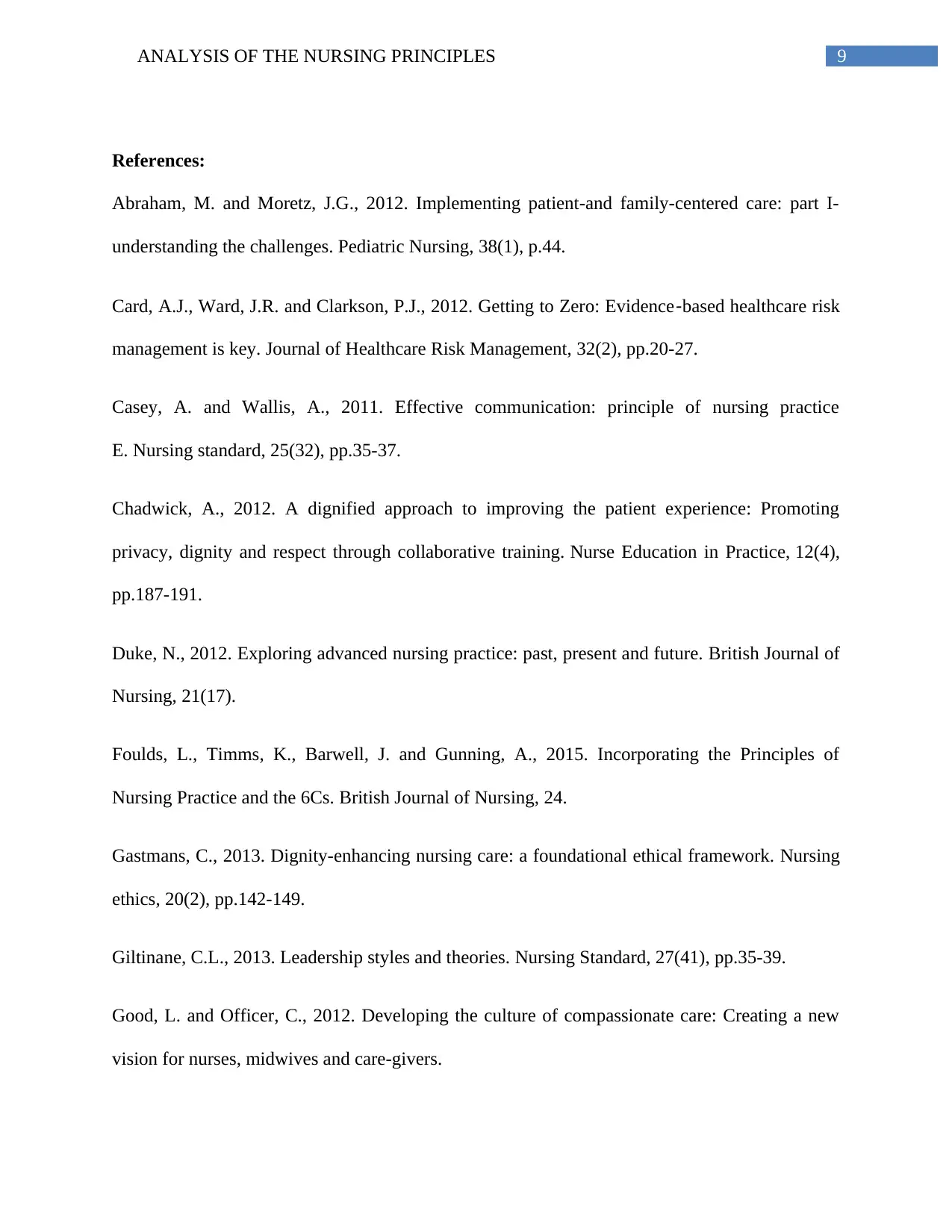
9ANALYSIS OF THE NURSING PRINCIPLES
References:
Abraham, M. and Moretz, J.G., 2012. Implementing patient-and family-centered care: part I-
understanding the challenges. Pediatric Nursing, 38(1), p.44.
Card, A.J., Ward, J.R. and Clarkson, P.J., 2012. Getting to Zero: Evidence‐based healthcare risk
management is key. Journal of Healthcare Risk Management, 32(2), pp.20-27.
Casey, A. and Wallis, A., 2011. Effective communication: principle of nursing practice
E. Nursing standard, 25(32), pp.35-37.
Chadwick, A., 2012. A dignified approach to improving the patient experience: Promoting
privacy, dignity and respect through collaborative training. Nurse Education in Practice, 12(4),
pp.187-191.
Duke, N., 2012. Exploring advanced nursing practice: past, present and future. British Journal of
Nursing, 21(17).
Foulds, L., Timms, K., Barwell, J. and Gunning, A., 2015. Incorporating the Principles of
Nursing Practice and the 6Cs. British Journal of Nursing, 24.
Gastmans, C., 2013. Dignity-enhancing nursing care: a foundational ethical framework. Nursing
ethics, 20(2), pp.142-149.
Giltinane, C.L., 2013. Leadership styles and theories. Nursing Standard, 27(41), pp.35-39.
Good, L. and Officer, C., 2012. Developing the culture of compassionate care: Creating a new
vision for nurses, midwives and care-givers.
References:
Abraham, M. and Moretz, J.G., 2012. Implementing patient-and family-centered care: part I-
understanding the challenges. Pediatric Nursing, 38(1), p.44.
Card, A.J., Ward, J.R. and Clarkson, P.J., 2012. Getting to Zero: Evidence‐based healthcare risk
management is key. Journal of Healthcare Risk Management, 32(2), pp.20-27.
Casey, A. and Wallis, A., 2011. Effective communication: principle of nursing practice
E. Nursing standard, 25(32), pp.35-37.
Chadwick, A., 2012. A dignified approach to improving the patient experience: Promoting
privacy, dignity and respect through collaborative training. Nurse Education in Practice, 12(4),
pp.187-191.
Duke, N., 2012. Exploring advanced nursing practice: past, present and future. British Journal of
Nursing, 21(17).
Foulds, L., Timms, K., Barwell, J. and Gunning, A., 2015. Incorporating the Principles of
Nursing Practice and the 6Cs. British Journal of Nursing, 24.
Gastmans, C., 2013. Dignity-enhancing nursing care: a foundational ethical framework. Nursing
ethics, 20(2), pp.142-149.
Giltinane, C.L., 2013. Leadership styles and theories. Nursing Standard, 27(41), pp.35-39.
Good, L. and Officer, C., 2012. Developing the culture of compassionate care: Creating a new
vision for nurses, midwives and care-givers.
Paraphrase This Document
Need a fresh take? Get an instant paraphrase of this document with our AI Paraphraser
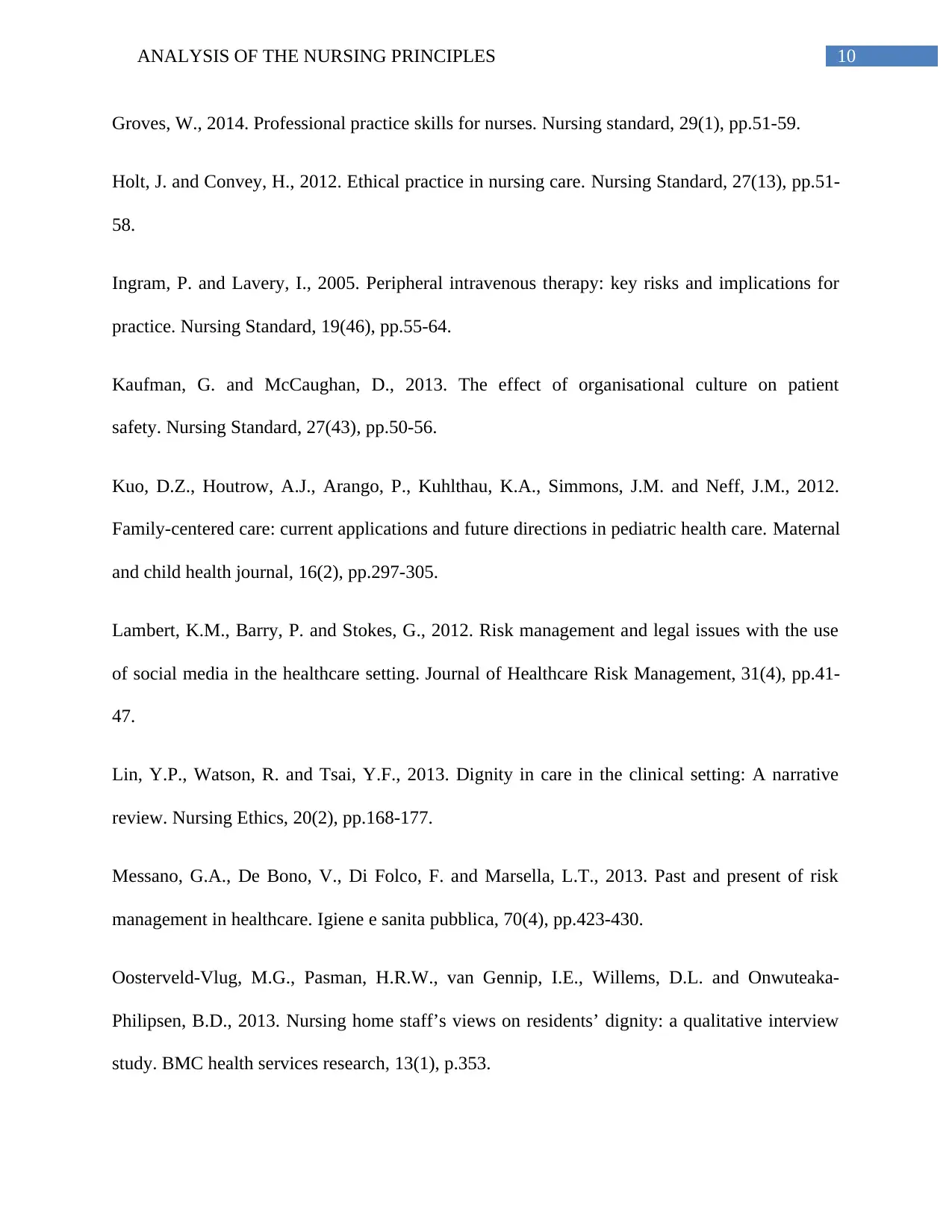
10ANALYSIS OF THE NURSING PRINCIPLES
Groves, W., 2014. Professional practice skills for nurses. Nursing standard, 29(1), pp.51-59.
Holt, J. and Convey, H., 2012. Ethical practice in nursing care. Nursing Standard, 27(13), pp.51-
58.
Ingram, P. and Lavery, I., 2005. Peripheral intravenous therapy: key risks and implications for
practice. Nursing Standard, 19(46), pp.55-64.
Kaufman, G. and McCaughan, D., 2013. The effect of organisational culture on patient
safety. Nursing Standard, 27(43), pp.50-56.
Kuo, D.Z., Houtrow, A.J., Arango, P., Kuhlthau, K.A., Simmons, J.M. and Neff, J.M., 2012.
Family-centered care: current applications and future directions in pediatric health care. Maternal
and child health journal, 16(2), pp.297-305.
Lambert, K.M., Barry, P. and Stokes, G., 2012. Risk management and legal issues with the use
of social media in the healthcare setting. Journal of Healthcare Risk Management, 31(4), pp.41-
47.
Lin, Y.P., Watson, R. and Tsai, Y.F., 2013. Dignity in care in the clinical setting: A narrative
review. Nursing Ethics, 20(2), pp.168-177.
Messano, G.A., De Bono, V., Di Folco, F. and Marsella, L.T., 2013. Past and present of risk
management in healthcare. Igiene e sanita pubblica, 70(4), pp.423-430.
Oosterveld-Vlug, M.G., Pasman, H.R.W., van Gennip, I.E., Willems, D.L. and Onwuteaka-
Philipsen, B.D., 2013. Nursing home staff’s views on residents’ dignity: a qualitative interview
study. BMC health services research, 13(1), p.353.
Groves, W., 2014. Professional practice skills for nurses. Nursing standard, 29(1), pp.51-59.
Holt, J. and Convey, H., 2012. Ethical practice in nursing care. Nursing Standard, 27(13), pp.51-
58.
Ingram, P. and Lavery, I., 2005. Peripheral intravenous therapy: key risks and implications for
practice. Nursing Standard, 19(46), pp.55-64.
Kaufman, G. and McCaughan, D., 2013. The effect of organisational culture on patient
safety. Nursing Standard, 27(43), pp.50-56.
Kuo, D.Z., Houtrow, A.J., Arango, P., Kuhlthau, K.A., Simmons, J.M. and Neff, J.M., 2012.
Family-centered care: current applications and future directions in pediatric health care. Maternal
and child health journal, 16(2), pp.297-305.
Lambert, K.M., Barry, P. and Stokes, G., 2012. Risk management and legal issues with the use
of social media in the healthcare setting. Journal of Healthcare Risk Management, 31(4), pp.41-
47.
Lin, Y.P., Watson, R. and Tsai, Y.F., 2013. Dignity in care in the clinical setting: A narrative
review. Nursing Ethics, 20(2), pp.168-177.
Messano, G.A., De Bono, V., Di Folco, F. and Marsella, L.T., 2013. Past and present of risk
management in healthcare. Igiene e sanita pubblica, 70(4), pp.423-430.
Oosterveld-Vlug, M.G., Pasman, H.R.W., van Gennip, I.E., Willems, D.L. and Onwuteaka-
Philipsen, B.D., 2013. Nursing home staff’s views on residents’ dignity: a qualitative interview
study. BMC health services research, 13(1), p.353.
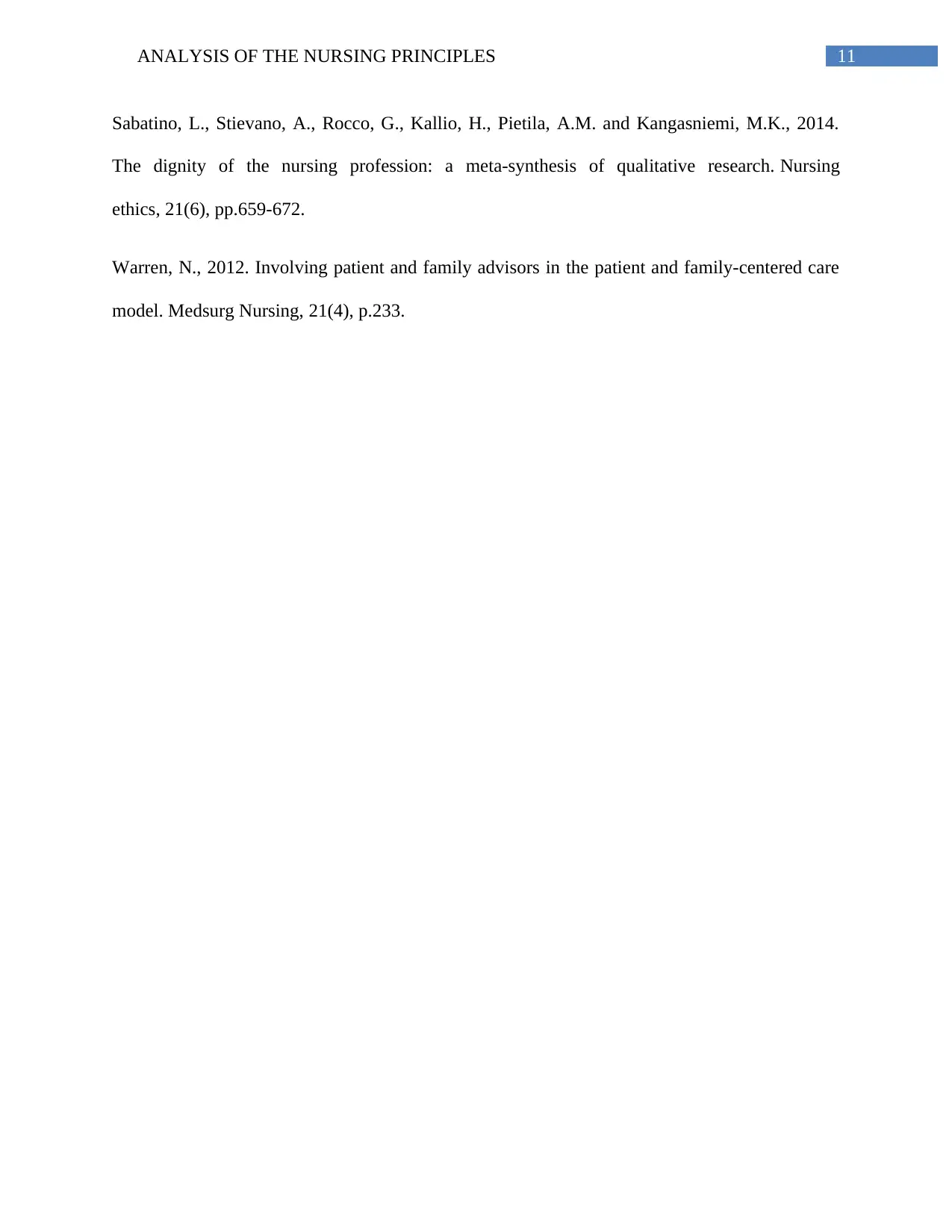
11ANALYSIS OF THE NURSING PRINCIPLES
Sabatino, L., Stievano, A., Rocco, G., Kallio, H., Pietila, A.M. and Kangasniemi, M.K., 2014.
The dignity of the nursing profession: a meta-synthesis of qualitative research. Nursing
ethics, 21(6), pp.659-672.
Warren, N., 2012. Involving patient and family advisors in the patient and family-centered care
model. Medsurg Nursing, 21(4), p.233.
Sabatino, L., Stievano, A., Rocco, G., Kallio, H., Pietila, A.M. and Kangasniemi, M.K., 2014.
The dignity of the nursing profession: a meta-synthesis of qualitative research. Nursing
ethics, 21(6), pp.659-672.
Warren, N., 2012. Involving patient and family advisors in the patient and family-centered care
model. Medsurg Nursing, 21(4), p.233.
⊘ This is a preview!⊘
Do you want full access?
Subscribe today to unlock all pages.

Trusted by 1+ million students worldwide
1 out of 12
Related Documents
Your All-in-One AI-Powered Toolkit for Academic Success.
+13062052269
info@desklib.com
Available 24*7 on WhatsApp / Email
![[object Object]](/_next/static/media/star-bottom.7253800d.svg)
Unlock your academic potential
Copyright © 2020–2025 A2Z Services. All Rights Reserved. Developed and managed by ZUCOL.





